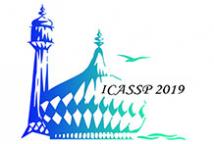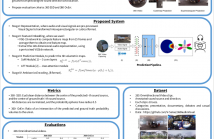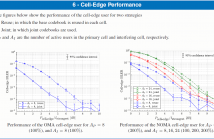
ICASSP is the world’s largest and most comprehensive technical conference focused on signal processing and its applications. The 2019 conference will feature world-class presentations by internationally renowned speakers, cutting-edge session topics and provide a fantastic opportunity to network with like-minded professionals from around the world. Visit website.
- Read more about LATENT REPRESENTATION LEARNING FOR ARTIFICIAL BANDWIDTH EXTENSION USING A CONDITIONAL VARIATIONAL AUTO-ENCODER
- Log in to post comments
Artificial bandwidth extension (ABE) algorithms can improve speech quality when wideband devices are used with narrowband
ICASSP2019.pdf
- Categories:
 48 Views
48 Views
- Read more about FREQUENCY-DOMAIN DECOUPLING FOR MIMO-GFDM SPATIAL MULTIPLEXING
- Log in to post comments
Generalized frequency division multiplexing (GFDM) is considered a nonorthogonal waveform and can cause difficulties when used in the spatial multiplexing mode of a multiple-input-multiple-output (MIMO) scenario. In this paper, a class of GFDM prototype filters, in which the GFDM system is free from inter subcarrier interference, is investigated, enabling frequency-domain decoupling during processing at the GFDM receiver. An efficient MIMO-GFDM detection method based on depth-first sphere decoding is subsequently proposed with this class of filters.
- Categories:
 45 Views
45 Views
- Read more about TOWARDS GENERATING AMBISONICS USING AUDIO-VISUAL CUE FOR VIRTUAL REALITY
- Log in to post comments
Ambisonics i.e., a full-sphere surround sound, is quintessential with 360° visual content to provide a realistic virtual reality (VR) experience. While 360° visual content capture gained a tremendous boost recently, the estimation of corresponding spatial sound is still challenging due to the required sound-field microphones or information about the sound-source locations. In this paper, we introduce a novel problem of generating Ambisonics in 360° videos using the audiovisual cue.
- Categories:
 20 Views
20 Views
- Read more about Joint Codebook Design for Multi-Cell NOMA
- Log in to post comments
For spreading-based multiple access, whether orthogonal (OMA) or non-orthogonal (NOMA), the spreading sequences (signatures) are selected from a predefined codebook. When operating in a cellular system, intercell interference will be inherently present between close base stations that share the same resources. If the codebook is reused across the different cells, then intercell interference can cause a full collision of the interfering users in the code-domain, thus deteriorating their performance, especially those at the cell-edge.
- Categories:
 49 Views
49 Views
- Read more about PhoneSpoof: A new dataset for spoofing attack detection in telephone channel
- Log in to post comments
The results of spoofing detection systems proposed during ASVspoof Challenges 2015 and 2017 confirmed the perspective in detection of unforseen spoofing trials in microphone channel. However, telephone channel presents much more challenging conditions for spoofing detection, due to limited bandwidth, various coding standards and channel effects. Research on the topic has thus far only made use of program codecs and other telephone channel emulations. Such emulations does not quite match the real telephone spoofing attacks.
- Categories:
 70 Views
70 Views
- Read more about On the Usefulness of Statistical Normalisation of Bottleneck Features for Speech Recognition
- Log in to post comments
DNNs play a major role in the state-of-the-art ASR systems. They can be used for extracting features and building probabilistic models for acoustic and language modelling. Despite their huge practical success, the level of theoretical understanding has remained shallow. This paper investigates DNNs from a statistical standpoint. In particular, the effect of activation functions on the distribution of the pre-activations and activations is investigated and discussed from both analytic and empirical viewpoints.
- Categories:
 19 Views
19 Views
- Read more about OBJECTIVE COMPARISON OF SPEECH ENHANCEMENT ALGORITHMS WITH HEARING LOSS SIMULATION
- Log in to post comments
Many speech enhancement algorithms have been proposed over the years and it has been shown that deep neural networks can lead to significant improvements. These algorithms, however, have not been validated for hearing-impaired listeners. Additionally, these algorithms are often evaluated under a limited range of signal-to-noise ratios (SNR). Here, we construct a diverse speech dataset with a broad range of SNRs and noises.
- Categories:
 56 Views
56 Views
- Read more about Occupancy pattern recognition with infrared array sensors: A Bayesian approach to multi-body tracking
- Log in to post comments
- Categories:
 64 Views
64 Views
- Read more about SPACE ALTERNATING VARIATIONAL ESTIMATION AND KRONECKER STRUCTURED DICTIONARY LEARNING
- Log in to post comments
In this paper, we address the fundamental problem of Sparse
Bayesian Learning (SBL), where the received signal is a high-order
tensor. We furthermore consider the problem of dictionary learning
(DL), where the tensor observations are assumed to be generated
from a Kronecker structured (KS) dictionary matrix multiplied by
the sparse coefficients. Exploiting the tensorial structure results in
a reduction in the number of degrees of freedom in the learning
problem, since the dimensions of each of the factor matrices are significantly
ICASSP19.pdf
- Categories:
 9 Views
9 Views